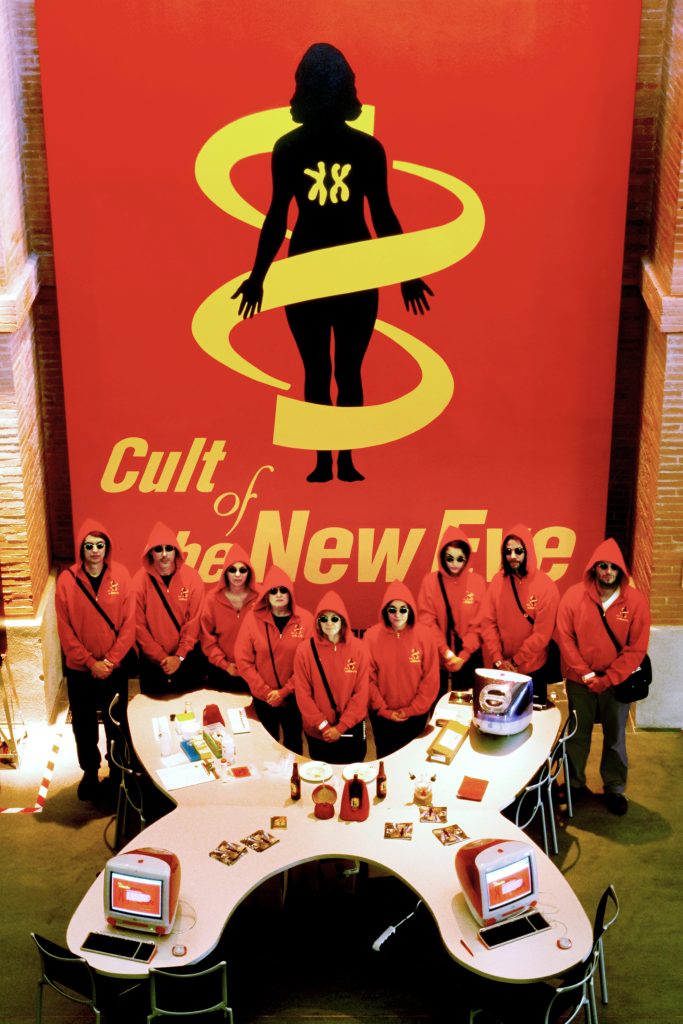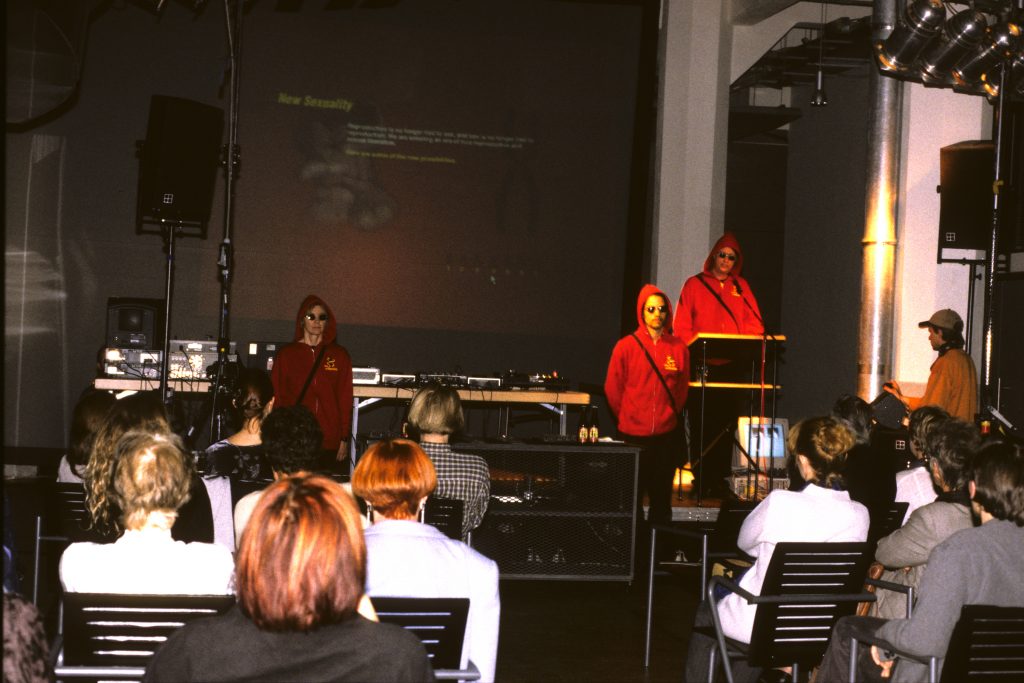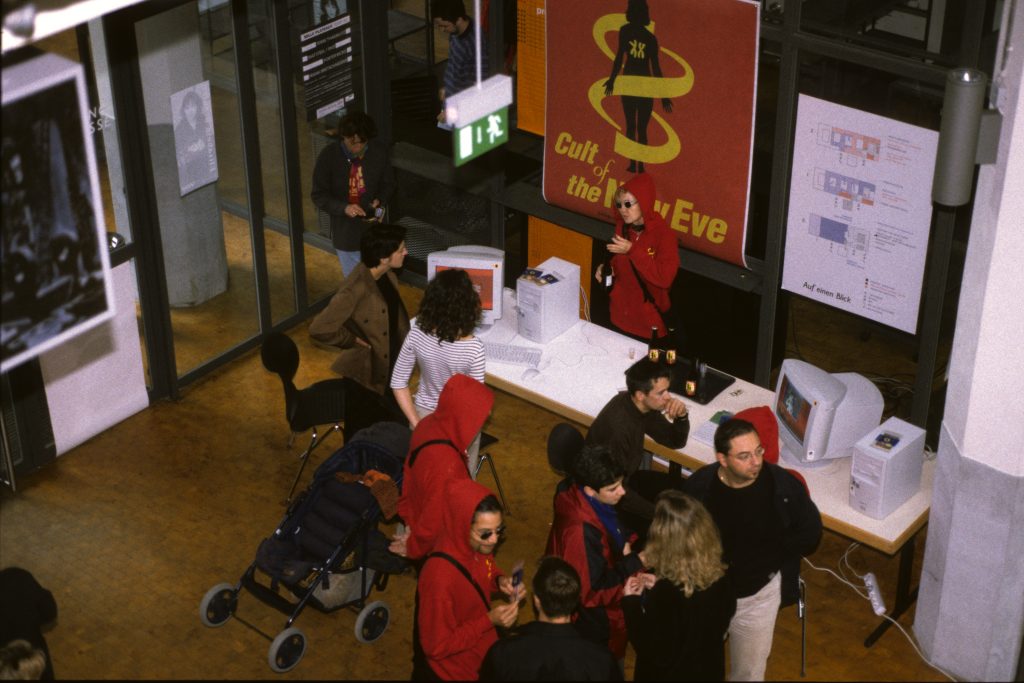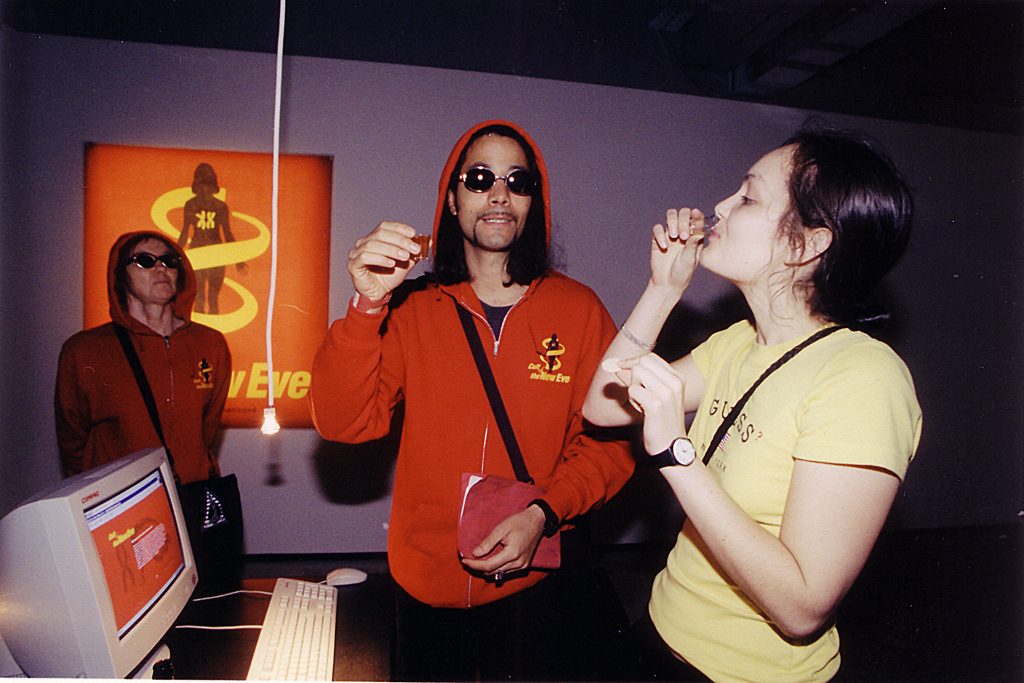
Installation view, Museum of Contemporary Art, Toulouse, France, 2000 This project examined the appropriation of Christian promissory rhetoric by industry and scientific specialists in order to persuade the public of the utopian nature of new biotechnology. CAE/Vanouse/Wilding moved this rhetoric from the context of the most legitimate and authoritative socio-economic constellations, and placed it in the context of the least legitimate of all social constellations—a cult—in order to give the public a new perception of this peculiar strain of social representation. In addition to Toulouse, Cult of the New Eve was performed at St. Clara Hospital, Rotterdam; Steirischer Herbst at ESC Gallery, Graz; the Center for Art and Media, Karlsruhe; and the World Information Organization at Brussels 2000.
This project examined the appropriation of Christian promissory rhetoric by industry and scientific specialists in order to persuade the public of the utopian nature of new biotechnology. CAE/Vanouse/Wilding moved this rhetoric from the context of the most legitimate and authoritative socio-economic constellations, and placed it in the context of the least legitimate of all social constellations—a cult—in order to give the public a new perception of this peculiar strain of social representation. In addition to Toulouse, Cult of the New Eve was performed at St. Clara Hospital, Rotterdam; Steirischer Herbst at ESC Gallery, Graz; the Center for Art and Media, Karlsruhe; and the World Information Organization at Brussels 2000.

Performance view, the lobby of St. Clara Hospital, Rotterdam, 2000 Participants gather information from the project website and talk with Cult of the New Eve performers about issues related to the new biotechnologies.
The Promissory Rhetoric of
Biotechnology in the Public Sphere
Just as the Christian soul has provided an archetypal concept through which to understand the person and the continuity of self, so DNA appears in popular culture as a soul-like entity, a holy and immortal relic, a forbidden territory. The similarity between the powers of DNA and those of the Christian soul, we suggest, is more than linguistic or metaphorical. DNA has taken on the social and cultural functions of the soul. It is the essential entity-the location of the true self-in the narratives of biological determinism.
-Dorothy Nelkin and Susan Lindee
Popular wisdom in western culture has long told us that science is our new religion. This trope has been repeated regularly since Turgenev’s creation of the nihilistic Bazarof and Nietzsche’s pronouncement of the death of God. Like most propositions derived from popular perception, there is an element of truth in it. Science is the institution of authority regarding the production of knowledge, and tends to replace this particular social function of conventional Christianity in the west. In keeping with this position, science has slowly but surely become a key myth maker within society, thus defining for the general population the structure and dynamics of the cosmos and the origins and makings of life, or, in other words, defining nature itself. Much as religion once defined the human role in the cosmos, science does the same in such a way that the political economy of the day seems to be a part of nature and attuned to its laws and imperatives. Certainly the theory of evolution is an example of science fulfilling the ideological needs of capital.
Science has never been very comfortable with its designation as the new religion, and rightly so. After all, the analogy is very loose, since science and religion share very few master narratives. The rhetoric of science has also generally strayed far from the rhetoric of theology. Science has developed its own language to represent itself to the public (i.e., those outside any scientific specialization), and the roots of its language are in the secularized speech of the Enlightenment. However, in the relationship between science and the public, we find a second suggestion of why science is often perceived as the new religion. Science is a key mediator of the public’s relationship with nature, much as the Roman Catholic Church in medieval times mediated its public’s relationship with God. Perhaps the Greens, with their simple, personal relationship with nature, could be our modern-day Protestants. Again, the analogy can start to get pretty silly when pushed too far, but in light of the new biotech revolution, this exercise may be a necessity.
As the key knowledge producer for capital, science finds itself in a subservient middle-management position. Popular wisdom fails us when one notes that science as an institution is not the Church of Innocent III. It is by no means a general seat of power; its power lies only in the particulars of knowledge production. Indeed, this position is one of privilege, but it has definite limits. It must account for itself, and do so in the way that capital demands by showing that its knowledge production is profitable (particularly in the form of application, hence the marriage of science and technology). Should it fail in this endeavor, it will not be the great mediator of nature for long; however, science has been very successful at impressing its boss for the past century, and shows no signs of retiring. It is willing and able to exclusively serve the needs of capital, not just by generating knowledge that can be applied for profit, but also by not generating any knowledge or applications that could be detrimental to the maintenance and/or expansion of the system (for example, science has avoided creating a car that does not use fossil fuel).

Center for Art and Media, Karlsruhe, Germany, 2000 Participants listen to a Cult member deliver a webcast sermon
In order to justify the selective nature of this variety of service, to impress and excite the various classes that monitor and distribute the investment capital marked for research and development, and to uphold its spectacle as a benevolent institution providing great marvels to the general public, science has constructed a rhetoric of promise derived from Enlightenment political principles to deploy either as a spectacle of seduction or deflection. This rhetorical system is most evident when the knowledge meets the public in the applied form of new technology. From the building of railways to the construction of the Internet, utopian promises regarding the latest technological phenomenon have deluged us. And like those in every generation since that of the mid-19th century, critics of technology have tried to puncture these inflated claims (although usually with only modest success). While much of this rhetoric does come from scientists for the reasons given above, they alone are not to blame. These promises only continue to inflate when redeployed by the marketing and media agents of capital and by a broad variety of capital’s ideologues. In this generation considerable time has been spent on critiquing the value of the Internet by leftist thinkers such as Pit Schultz, Geert Lovink, Richard Barbrook, Konrad Becker, Lev Manovich, Inke Arns, Oliver Marchart, Matt Fuller, Mark Dery, Critical Art Ensemble, and many others. They have endeavored to deflate the promises of marketers in their many guises, to reveal the ideological infrastructure of the technology and its representation, and to demonstrate that even the smallest utopian possibility contained in the rhetoric would probably not be generally realized by most of the world’s population.
While the promises made about technology are many and appear in various permutations, they tend to fall into four main categories-democracy, liberty, efficiency, and progress. Democracy appears as the notion that everyone will be empowered by the new technology, and thereby have increased agency within the social realm. For example, one promise is that new transportation technology (the elder of the techno-revolutions birthed with capital’s commitment to trains) will create a cosmopolitan state in which no one is restricted by spatial limits. Of course there is no real gain, only relative gain. Class structure replicates itself in the technology. Class strata reveal themselves in who can go farther, faster, more often, and in what degree of comfort. While a less privileged person can travel farther than ever before if so inclined, the relative distance between what members of different classes can and are likely to do remains about the same (or increases).

World Information Organization, Brussels, 2000 Cult members solicit participants and and proselytize in the street.
Liberty is usually presented in terms of freedom from restrictive social elements. This promise can take many forms. Liberation from drudgery in the form of work is an example of a typical form; however, decades of technoculture have taught us only that the greater the intensity of technology, the greater the workload. Much the same is true of efficiency. Improved efficiency only means more profit and speed for capital, while the implied promise of individual benefit never seems to materialize. Taken together, a working definition of progress emerges that means nothing more than the expansion of capital, but presents itself as advancement of the common good.
This collection of rhetorical truisms has worked well for over a hundred years, ushering in numerous innovations both mechanical and electrical, both analogic and digital, with strong public support. As the biotech revolution is being set into motion, the standard practice of parading the utopian principles of bourgeois society should be happening again, but strangely enough, it isn’t. The problem is that history is disrupting the deployment of another round of the same old promises. Biology tried to have its social revolution once before (before it was technically ready to carry it out), when it was believed that Darwinism could explain the nature of biological process and its relationship to social “progress.” The usual promises were made: real democracy would emerge through biological engineering, because all citizens would be fit agents for political action. A truly self-aware, self-generating equality would emerge. People would be liberated from biological destiny by controlling it themselves, and would be able to apply the values and morals of society to the production of the flesh. In this manner, biological progress would parallel technological progress.

Transgenic beer and wafer containing a random genome library of the New Eve (the first volunteer for the Human Genome Project) used for Cult sacraments.
What appeared instead was the horror show of eugenics that spawned unspeakable atrocities. The utopian mask fell from capital’s face, and the sight was repulsive: selective breeding, forced abortions and sterilizations, and in the worst cases, genocide. All excess populations (i.e., those of no use to capital) were viciously attacked or done away with. At the other end of the spectrum (positive eugenics), capital worked on a biological means to replicate the populations it required by socially rewarding those who bred for health, intelligence, and moral character.
The eugenic initiative sliced a wound so deep into the social body that it has yet to fully heal. To this day it remains a painful memory that is almost impossible to acknowledge. In the U.S., eugenics is considered something dead and best forgotten. Few American authorities acknowledge that the U.S. was a leader in eugenic philosophy and practice. The feeling is that it happened somewhere else (probably in Germany, where there were Nazis). Unfortunately for the new generation of geneticists and molecular biologists, the utopian rhetoric that once served other science and technology producers so well is now tainted. Using such language could raise up ghosts from the past that are better left to rest. Since the public has already seen the true face of capital and its plans for the flesh (invasion and instrumentalization), it would not be wise to use representation that could encourage remembrance of this vision, because it could lead to a popular condemnation of the new trajectory of flesh sciences.
The question now is, what rhetoric can be used to represent the new biological initiative so that it can keep its distance from eugenics? If the secular rhetoric of the Enlightenment is off limits, then what is left? One good place to turn is the utopian rhetoric of Christianity (and the Roman Catholic Church in particular).* The Church survived the eugenics movement reasonably unscathed-at least to the extent that it was not seen as a primary initiator of the movement, and in some cases was an open critic of it. Why the Church acted this way is open to question. Clearly, the idea that creation could be appropriated by humans would not sit well with the Church, and hence its position was to defend its belief system from a secular hubris that was out of control. However, one could also argue that Church denunciation of eugenics was self-serving. For example, between 1900 and 1920, many of the marginalized groups in the U.S. that would be negatively affected by the eugenics movement, such as the Poles, the Italians, and the Irish, were largely Catholic. The Church could lose its constituency in America, and hence its public outcry. This notion of self service is reinforced by the fact that such protectionism wore off later in the century when the Jews became the primary target group affected by eugenics. Be that as it may, the rhetoric of origination and creation used by the Church remained disassociated from eugenics, so its rhetoric is still open to appropriation for those with the authority to use it.
Returning to the popular wisdom that science is our new religion, in the case of the biotech revolution there may well be an additional element of truth. The spiritual promises of a dying institution are now being reborn as a material reality that is not dependent on faith. In the process, perhaps we are witnessing another attempt to solve the conundrum of the skeptic who wants to believe. This problem was eloquently presented by Dostoyevsky through the character Ivan in The Brothers Karamazov. Ivan has a desire to believe in God, but His envelopment in mystery and otherworldliness leaves Him unaccountable for the evils in the world. If indeed there is a God, the empirical proof of His incompetence is overwhelming. For instance, Ivan saves newspaper clippings of atrocities committed against children. How can a good and righteous God allow such things to happen? In deciding between God and justice (the secular), Ivan feels compelled to choose justice, but suffers greatly for this choice. Here at the next fin de siécle, this paradox of psychological suffering is no longer so perplexing. All that was once shrouded in mystery is now open to accountability and measurement. The choice is neither to push through the absurd and leap into transcendental worlds through uncompromising faith, nor side with justice at the expense of an empty soul; rather, the best option is to understand that redemption is grounded in the material. Whether speaking of questions about a new genesis, healing, universal connectedness, or even immortality, the answers are to be found in molecular strata beyond operational reality; however, this other realm can be measured, modeled, catalogued, and manipulated. Controlled access to creation, life, and the cosmos should be considered the solution to Ivan’s dilemma.
The Quest for the New Eve
Biblical signs and symbols are entrenched in western culture. From childhood, we are taught to recognize and interpret them. For this reason biblical metaphor has always been an excellent resource for specialized culture to use in speaking to popular culture. Eve is one of those symbols that is immediately recognizable, for even the undereducated and/or the staunchly secular have had this sign of origination embedded in their cultural vocabulary. Since the legitimation of the theory of evolution, science has had a begrudgingly antagonistic relationship with creationist theory, which clings to the literal interpretation of the sign of Eve and the narrative of Genesis. It would be best if the creationists just went away and left science to its work, but like pesky gadflies they keep on challenging evolutionary theory with arguments solely supported by unfounded propositions contained in a sacred book. As the popular wisdom of the American bumper sticker flatly states: “The Bible says it, I believe it, that’s the end of it.” In order to speak back to the nonspecialized public regarding the matter of the origin of life, science has managed to more than swat at the creationists with its partly empirically buttressed arguments-it has appropriated its symbol. We now have a Simian Eve-a lovely australopithecus found in Africa, and believed to be the oldest of our human ancestors. (One must note that while she is the Simian Eve, she is also known as Lucy, named for the Beatles song playing at the moment of her discovery.) Science corrected the Biblical misconception a second time by empirically proving that the first Homo sapiens woman was of African origin and appeared somewhere between 100,000 and 400,000 years ago. She is known as Mitochondrial Eve after the genetic trait used to trace her origin and clock her age. The broad approximation of her age is due to uncertainty among scientists as to how the mitochondrial clock works. One thing they do agree on is that the first Homo sapiens is older than the 6,000 plus years that Christian fundamentalist scholars claim for Eve.
The Human Genome Project has one last Eve for science to offer us. She is the one who will help the public understand the beginning of a second genesis-one that is not beholden to any reproductive boundaries that once separated the species-and to understand it as a good thing. She is Eve without the fall-an Eve of perpetual grace, but most amusingly, she is a random Eve.
The mythology of this Eve goes as follows, although the narrative tended to vary slightly with each scientist CAE interviewed: When the Human Genome Project (HGP) began its mission of mapping and sequencing the entire human genome, it needed DNA in order to start. Since HGP was an academic/government initiative, ethics committees were established to make sure that this genetic investigation did not go into territories best left unexplored. One of the concerns among all the participants was to insure that those who donated blood to the project would do so anonymously, so their identities would be protected from the media and various objecters to the project who might harass willing participants. A review board with strict procedures was set up to insure the privacy of blood donors. However, after the first donor was approved, no other donors were needed. The DNA of the first approved volunteer was mass produced (copied) as needed. Why go to the trouble and expense of having any more? After all, one donor is sufficient for the project’s needs. What is known about this donor is that she is a woman from Buffalo, New York. She is the Eve of the second genesis. It will be a curious sight to see if she, too, is labeled by science with the sign of origination.
New Nature
The ability to copy and recombine presents a cosmological paradox. On the one hand, the creatures of earth, plant and animal, great and small, no longer have any essential traits. Postmodern theory made this proposition years ago, claiming that all qualities are a matter of performativity grounded in the social, and are always already becoming other. To prove their proposition, theorists scoured the planet for evidence that contradicted biological universals. For example, Judith Butler followed this formula when studying human sex and gender. In order to show that gender was a category of becoming rather than being, she struck directly at medical and social essentialism by citing examples of persons who had male genitalia but double X chromosomes, and hermaphrodites who had both male and female genitalia. This demonstrated that the choice of gender is an arbitrary medical determination reinforced by the dramaturgy of everyday life. While these biological manifestations are relatively rare, they occur regularly enough to call into question any universalist claim about gender. Now that DNA can be replicated and spliced at will, the concept of the individual (or any living thing) as a temporary set of organic relations could become an operational norm. Even Butler would have to admit that, just ten years ago, gendering was bounded by the limits of sexual reproduction. In the new version of nature, there are no limits. The species is completely boundless (in fact, the idea of a species may now be a biological anachronism). DNA is DNA is DNA, and so the DNA from one species can be recombined with the DNA of another. The DNA could come from hundreds of donors, all from different species. To use Guattari’s terms, we are now literally becoming plant and becoming animal. These abilities to copy and recombine can be used to remake the world, and design life in a manner that creates heaven on earth, a process that molecular biologist Lee Silver calls “remaking Eden.”
On the other hand, if all DNA is compatible, is this not the essential link between all living creatures? Here is a new universalism-the proverbial “we are all one” at the molecular level. Or, as Mellon Professor of the Sciences Edward O. Wilson puts it:
We are literally kin to other organisms…. About 99 percent of our genes are identical to the corresponding set in chimpanzees, so that the remaining 1 percent accounts for all the differences between us…. Aren’t these small steps gradually enlarging the self by degrees until the self is identified with more and more others?
To once again use the language of Deleuze and Guattari, we will be able to escape the tyranny of the arboreal that emphasizes the perception of interspecies relationships as fragmented and separate, and thus becoming ever more remote from one another in their complexity, and hence, forever more specialized. Instead the living world will become viewed as more rhizomatic, with each point immediately connected to any other point. In this case, our own survival and development is intimately connected to that of all other living things.
This new universalism will have a dramatic impact on how we perceive the world, and how we act in it. For example, the new universalism will revolutionize medicine (such as in pharmacology and gene therapy as answers to surgery and other forms of mechanical invasion), but will also revolutionize the very worldview of medicine itself. Many now complain that modern medicine has become fragmented and wish to return to older holistic models. Prior to the development of western modern medicine, western medical practice was dominated by a form of holistic healing based on the Galenic system of the four humors that determined the character of the person. In this model the doctor was interested in the patient as a whole-activities (both material and spiritual), environment, diet, and so on. With the emergence of modern medicine in the 19th century, this type of practice was abandoned and medical practice became much more specialized in its interests. It focused on the micro-level, concentrating on cellular pathologies and micro-body invaders (i.e., germs), and de-emphasized the person as a whole or the influence of he/r daily life on he/r health. In light of the new universalism, medicine could return to a new consideration of the patient; anything (environmental conditions for example) that affects the molecular level (rather than focusing on the cell/germ face-off and surgical intervention) could become significant, and therapy could be skewed toward molecular prevention rather than toward cure and symptom arrest.
To be sure, this new paradox, in which the temporary and the permanent exist in the same moment, is going to be presented as a win-win situation. Whether we are redesigning ourselves, or learning to understand our natural interconnectedness in a tangible (as opposed to mystical) way, good things are going to happen. These promises go to the extreme of offering the material reality of immortality (and not as an angel or condemned soul). In regard to immortality, there are cautious promises such as this one by Professor of Biochemistry S. Michal Jazwinski:
We are generating transgenic worms and mice to test the hypothesis that at least some of the longevity genes isolated in yeast are important in aging in mammals. If we can validate this notion, we will have contributed a foundation for drug discovery efforts aimed at ameliorating some of the deficits of old age. This in turn would help to further our goal for everyone to “die young at an old age.”
And wild promises such as this one from Michael Rose, Professor of Evolutionary Biology at the University of California at Irvine:
Death rates go up sharply with increasing age, but once you go off the edge of that ramp, you reach a plateau where you are dependent on the quality of your cell repair capability…. I believe there are already immortal people and immortal fruit flies. We just need to get the benefits of these genes conferring immortality at a younger age, before we suffer too much damage.
Some biologists are convinced that they are coming to understand the mechanisms of aging and cell repair. For example, one hypothesis is that every time a chromosome directs a cell to divide, a small piece is shaved off the chromosome’s tip. When the tip becomes too short it stops directing the cell to divide, and cell repair stops. As the nonreproductive cell ages it can begin to malfunction, and here the problems of aging really begin. Biologists believe that if they can find a way to maintain the tip, it will never give the cell the message to stop dividing, and in this manner we can combat age, fight certain illnesses, and perhaps live forever. This discovery is doubly exciting because it has long been known that some animals, turtles for example, do not age (decay). Perhaps a lifelong process of cell repair can be initiated in humans through molecular therapy.
As always, capital makes techno-revolutions sound good, and to the extent that the interests of individuals and of capital overlap, the revolution will be good. Unfortunately, we do not know how big this overlap will be, and if we are to judge from past experience, we can expect much more to be worse than better. Further, while the utopian promises have yet to really manifest themselves, the numerous problems (too numerous and too great to list here) are already manifesting themselves.
The most gruesome of these problems is the rebirth of eugenics. This time, it is primarily a positive eugenics that has returned in a form designed to solve the problem of workforce replication during a time of rapid economic change and expansion.** Now that humans have become a temporary set of biological relationships, an opportunity has arisen to redesign their biological matrix to better fit the needs of capital. To those who submit their offspring for redesign, capital promises in return to give that child a predisposition for a competitive edge in the open market (higher intelligence, better health, better dexterity, more desirable appearance, etc). This form of positive eugenics is market-driven, and pays for itself, thereby killing two birds with one stone by achieving both profits and a better worker/citizen. The values/needs of capital are now being inscribed on the body at a molecular level. Just how far this redesign process will go remains to be seen. Currently, very simple forms of choices are offered, such as sperm or egg donors with particular traits, embryonic testing (at four or eight cells) followed by embryonic self-termination if the quality is not up to standard, selective reduction of multiple fetuses, and so on. Recombinant traits have not been introduced yet, but given capital’s values of profit, speed, and expansion, above all else there is no reason to believe the exeriments in redesigning will not continue (most likely they will be presented as medical research).
The second major problem revolves around privatization. Under the hegemony of capital it is a miracle that we are not paying for air, or that there isn’t a tax on it at the very least. However, we will soon have to pay for our genes, because no biological resource from the molecular level on up will remain in the public domain. All useful/profitable genes and biochemicals from various genomes are being privatized and patented. Emblematic of this tendency is the patenting of azadirachtin, derived from the neem tree of India. This tree has been known for centuries for its general cure-all traits (but it is particularly helpful in relieving infection) and as a natural pesticide. W. R. Grace isolated the plant’s most useful chemical (azadirachtin) and patented it. While the isolation process was known to Indian companies, they did not patent it; the neem, along with its helpful properties and the knowledge of how to use them, was considered to reside in the public domain. After all, understanding of how to use the medicinal and other useful properties of the tree had developed over centuries. In a direct act of colonial aggression-eco-piracy by any other term-W. R. Grace appropriated and now has relative control of a traditional public resource.
The final problem is the ecological need for diversity. Biological diversity among species and within species that share the same operational realm as humans is beginning to dwindle. The truth of the matter is that monoculturing is very profitable in the short term, even though it may spell disaster in the long term, particularly in regard to food production. Industrial farming is always looking for ways to maximize land use and to grow as robust a product as possible. Consequently, those plant varieties that are less robust or for whatever reason require too many resources to produce are being lost. For example, at the turn of the century there were over 7,000 varieties of apples grown in the U.S.; now there are less than 1,000. This interspecies diversity is a natural defense against parasites and diseases. Should an apple tree disease similar to the Dutch Elm disease sweep through this population with its diminished variety, the chance is small that one of the varieties will have a natural defense against it. Imagine this problem affecting already monocultured staples like soy or wheat. Industrial farming techniques, pushed to the limits by the need to remain competitive in price, are forcing farmers to use recombinant seeds developed by corporations. The profit machine is on, and not even the threat of ecological disaster will turn it off.
Conclusion: On Miracles
To the philosopher of skepticism, David Hume, a miracle is “a violation of the laws of nature.” In Hume’s day one of these laws was that only members of the same species could breed via gendered pairing. This is no longer true. Is the new biology a miracle in this sense, or is it that there is no nature left whose laws can be violated? Is all that is left a collection of resources to be managed for the generation of profits? Many of the new miracles spoken of in this essay are truly wonderful unto themselves, but as they are assimilated into the system, they evolve into creatures less reminiscent of those in the peaceable kingdom of Eden, and become more akin to the predators of the Hobbesian war of all against all. There is no rhetoric glorious enough, not even the rhetoric of the miraculous, that can hide humanity’s tragic trajectory under the rule of pancapitalism.

